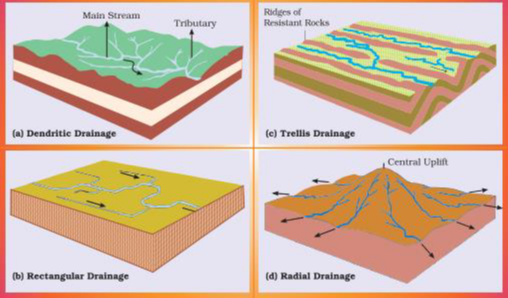4.1. Drainage Pattern
A geometric arrangement of streams in a region; determined by slope, differing rock resistance to weathering and erosion, climate, hydrologic variability, and structural controls of the landscape is known as drainage pattern. The rivers that existed before the upheaval of the
Himalayas and cut their courses by making gorges in the mountains are knows as the antecedent rivers. Indus, Satluj, Ganga are some important antecedent rivers. The rivers which follow general direction of slope are known as the consequent rivers. Godavari and Krishna etc. rivers descending from the Western Ghats are some consequent rivers.
The drainage pattern resembling the branches of a tree is known as “dendritic” the examples of which are the rivers of northern plain. It develops where the river channel follows the slope of the terrain. When the rivers originate from a hill and flow in all directions, the drainage pattern is known as ‘radial’. The rivers originating from the Amarkantak range present a good example of it. When the primary tributaries of rivers flow parallel to each other and secondary tributaries join them at right angles, the pattern is known as ‘trellis’. It develops where hard and soft rocks exist parallel to each other. Right bank tributaries of Brahmaputra rivers make trellis pattern while the left bank tributaries exhibit the

